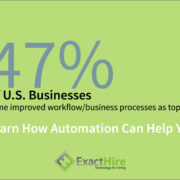The Eagle Has Landed: Employee Onboarding
Competition for talented employees in today’s job market is fierce. The balance of power has swung in favor of the talented job seeker. And since these job seekers have multiple job opportunities to consider, they’re not just looking for a job that pays the bills; they’re looking for a work experience that enhances their lives.
According to the Society for Human Resource Management’s (SHRM) August 2015 LINE Report, recruiting difficulty reached a 4-year high last July, which also made it 15 consecutive months of increase. In response to this ongoing challenge, many organizations are taking a closer look at their strategy for recruiting, hiring, and retaining top talent.
Let Me Fly You To The Moon
Small- to medium-sized businesses are investing in employer brand marketing that attracts applicants and persuades candidates. They are adding “perks” and “fun” to enhance their work culture. They are saying and showing all the right things during the recruitment and hiring phases. And that is all right and good. But too often, new hires are experiencing a disconnect between the marketing (pre-hire) and the reality (post-hire).
Some employers are over-promising, but most are simply too slow in delivering on their promises. Regardless of the cause, the disconnect is driving employee turnover. In the past year, nearly 43% of job turnover consisted of workers with less than 6 months on the job.
Houston, We Have A Problem
If an organization promises the moon to candidates, but then forces new hires to wait a year before getting them there, then that organization has a problem. And that problem most likely lies in new employee onboarding–the period of time between job offer acceptance and a new hire’s complete assimilation into a new organization.
Poor onboarding does not inspire new employees, and it certainly doesn’t enhance their lives. Employers have 90 days to convince new employees that they have accepted a job with the right organization; after that, those new hires will likely begin looking for another opportunity. Examples of ineffective onboarding include:
- Initial days of work exclusively focused on new hire paperwork
- Cold welcome from co-workers
- Choppy workflow and vague guidance or instructions
- Heavy, intensive training with little time to socialize with coworkers
- Role is unclear or widely differs from original description
- Lack of resources or proactive provisioning
- No training plan or preliminary goals
- Miscommunication between stakeholders (those charged with onboarding new hires)
Most of these symptoms of ineffective onboarding can be traced to one of two root causes: the organization does not have enough time to commit to employee onboarding; or the organization does not value onboarding.
Many small- to medium-sized businesses are stretched on time–that’s likely why they’re hiring in the first place. And it’s also likely that these missteps will be corrected as the organizations grow and gain greater efficiency in onboarding. On the other hand, if an organization is ineffectively onboarding employees because it doesn’t find it important, then it’s unlikely improvement will be gained, and the results of that can be devastating.
SHRM places the direct costs of rehiring for a position at 50%-60% of an employee’s salary. Indirect costs can rise to 200% in some cases! Clearly, poor onboarding damages more than an organization’s reputation or employee morale, it impacts the bottom line.
All Hands On Deck
Onboarding is one of the most overlooked and undervalued areas of the employee lifecycle. This is likely because the definition of onboarding–its length, its content, its purpose–has varied between industries, organizations, and even departments within organizations. To improve the onboarding process, an organization’s leaders must first gain a common understanding of the purpose and desired outcomes–a vision–for the onboarding process. From there, it’s a matter of building a plan for employee onboarding process improvement that serves the shared vision.
ExactHire has published a free ebook, All Hands On Deck: A Guide To Employee Onboarding Process Improvement, that offers guidance on the best practices for employee onboarding, including:
- Expanding your onboarding definition
- Identifying common problems
- Making a business case for change
- Calculating the ROI of onboarding technology
- Laying the framework
- Implementing innovative ideas
- Maintaining a continuous feedback loop
- Spotting trends in onboarding process automation
This resource is designed to help organizations gain a competitive advantage by realizing the opportunities of best-in-class employee onboarding.
We Have Liftoff
Smart organizations are seeking to improve their employee onboarding processes. With effective stakeholder engagement, documented process milestones, and an infusion of automation technology, these organizations are increasing onboarding efficiency. As a result, employee turnover is reduced and new employees are becoming productive more quickly. All of this positively impacts employer brand, while also driving business outcomes.
ExactHire offers hiring and employee onboarding software to growing small- to medium-sized businesses that are looking to efficiently attract, hire, and retain exceptional talent for continued growth. To learn more about ExactHire’s HR solutions, please submit a brief contact form.







